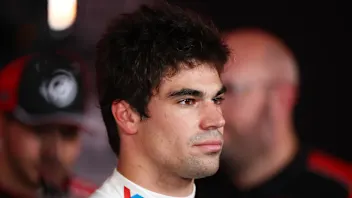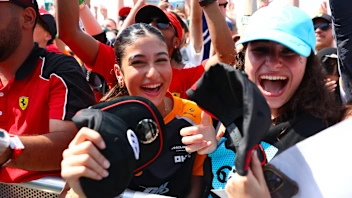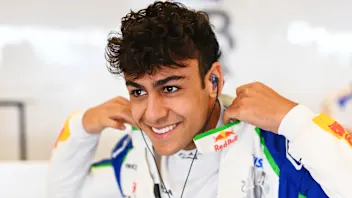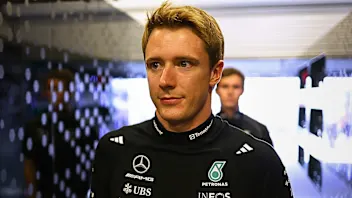From safety gear to storytelling – the evolution of F1’s special edition helmets
From Lando Norris’ disco ball to Alex Albon’s Miami orange, special edition helmets have been everywhere this season. We take a look back at where it all began.


Special edition helmets are a relatively recent addition to Formula 1's long history – what was once purely a piece of safety equipment has become a canvas for drivers and sponsors to showcase their personality, pay tribute or have some fun.
The journey from mostly plain lids to glittering, custom-designed works of art has been full of experimentation over the years – including design restrictions and concerns about the weight of paint. Here's a look back at how special edition helmets became a beloved part of F1's identity.
The early days: one design for an entire career
In a sport where faces are hidden behind visors, a helmet has always been a driver’s signature. For decades, drivers such as James Hunt, John Surtees, and Sir Jackie Stewart kept the same design throughout their entire careers.
Back then, helmets weren't nearly as protective, and their main purpose besides safety was for the fans and marshals to tell the drivers apart. Even so, individuality did shine through at time. Hunt's name stretched boldly along the side of his helmet, while Stewart paid homage to his Scottish roots with a tartan band around the crown.
Few designs, however, are as instantly recognisable as Ayrton Senna’s yellow, green and blue helmet – an enduring Brazilian icon that once fetched nearly $1million at auction.
For much of F1’s history, a helmet represented the driver but not the team. That began to change when Michael Schumacher moved to Ferrari and decided to replace the German flag on his helmet with a bright red design to match his new team's colours. This marked the start of a new, more flexible era, one where creativity and collaboration between driver and team became the norm.
The artists behind the designs
Helmet designs don't come out of thin air, and every special edition helmet begins with an artist – both a designer and engineer. Two of the best-known names in this profession are Jens Munser and Mad 56.
Munser, the mastermind behind Schumacher's Ferrari-era lids, Lando Norris's squiggles, and Sebastian Vettel's 2024 Imola Senna tribute explained to Motorsport Tech Magazine: “The process hasn’t changed much – we still start with sketches – but we now use printed stickers for logos instead of hand-painting every detail. We’ve improved the pigments to make paint lighter and more resistant to stones. Michael always wanted to save weight, even if it meant a less glossy finish.”
Mad 56, real name Massimo Dante, works primarily with Red Bull and has also collaborated with Williams driver Alex Albon for more than a decade. Though artists have creative freedom, they must balance aesthetics with FIA regulations and sponsor requirements, which is a tricky art in itself.
The 2015 ban: five years of restrictions
In 2015, the FIA announced that drivers must stick to a single helmet design during the entire season, as some of the constantly changing special edition helmets were starting to cause issues. The reasoning was simple: fans, commentators, and race officials were struggling to recognise who was behind the wheel!
The move came after a series of increasingly elaborate designs – most famously Sebastian Vettel’s 2012 LED-lit helmet in Singapore. The glowing design, while undoubtedly eye-catching, raised safety concerns and was quickly banned, prompting the FIA to rethink just how far helmet customisation should go.
The single-design regulation remained in place until 2020, but even under those tighter rules, creativity didn’t disappear. Designers found clever ways to work within the limits – for example, Lewis Hamilton’s special edition Mexico City Grand Prix helmets, or Sebastian Vettel subtly changing the colour of his usual helmet at the Monaco Grand Prix in 2017.
When the ban was lifted at the beginning of 2020, a wave of colour and creativity returned to the grid – and it hasn’t slowed down since.

The modern era: creativity, freedom, and meaning
Today, F1’s grid is awash with one-off designs, each a reflection of personality, heritage, and at times – humour. Amongst his many iconic special edition helmets, Lewis Hamilton collaborated with Japanese artist Hajime Sorayama for a chrome-inspired Japanese Grand Prix special in 2023, Valtteri Bottas once ran a pre-season helmet modelled on his own head, and Albon’s designs often pay tribute to his pets and his home nation of Thailand.
The 2025 season has also seen plenty of eye-catching limited-edition designs – from bold artistic statements to heartfelt tributes. One standout came from the youngest designer yet, Thea, the young fan behind Carlos Sainz’s unofficial mascot “Sparkles” the unicorn. The Spaniard wore Thea's design as a sticker on his helmet for the Azerbaijan Grand Prix and, while it was meant as a one-off, after his P3 finish in Baku, there’s no wonder he’d want his new mascot to stick around!
While some special edition helmet designs are lighthearted, others carry deep personal significance. One of the best examples of this was Romain Grosjean during his return to the Haas garage for Pirelli tyre testing, where he was finally able to wear the helmet that his children had designed for his planned 2020 farewell race – one he never got to use after his terrifying Bahrain crash.
It was a very sentimental helmet and reaffirmed that special edition helmets can be much more than just a marketing tool when they hold such meaning for the drivers.
Next Up
Related Articles
 Celebrating the first F1 Allwyn Global Community Awards
Celebrating the first F1 Allwyn Global Community Awards Stroll opens up on 'noise' that has followed him in F1
Stroll opens up on 'noise' that has followed him in F1 Formula 1’s record-breaking 2025 season in numbers
Formula 1’s record-breaking 2025 season in numbers Lindblad's car number confirmed for rookie season
Lindblad's car number confirmed for rookie season EXPLAINED: The key terms for F1’s new-for-2026 rules
EXPLAINED: The key terms for F1’s new-for-2026 rules ExclusiveVesti on life as Mercedes reserve and his F1 plan
ExclusiveVesti on life as Mercedes reserve and his F1 plan